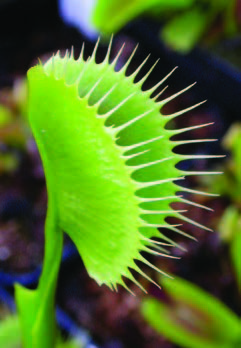|
Carnivorous Plant Newsletter
Volume 43, Number 2, June 2014, pages 74 - 75
New Cultivars
Sarracenia ‘Yellow Eel’
Dionaea ‘Sonic’
Sarracenia ‘Yellow Eel’
Submitted: 16 February 2014
Sarracenia ‘Yellow Eel’ was produced by transferring the pollen from a S. alata × psittacina to a S. alata seed parent on 3 October 2007. The seeds began germinating on 23 June 2008. Plants are currently in their 5th year of growth. The pollen parent has pitchers that are red in color with small white fenestrations and veining around the hood and top section of the pitcher, and has a closed hood with a small opening that represents the pitcher’s mouth. Its flowers produce red petals. The seed parent is a very vigorous plant that produces tall green pitchers about 60 cm tall, has light red venation on the pitcher’s exterior and more prominent veining on the interior surface, with the underside of the lid red. It produces light green to yellow petals.
The resulting Sarracenia ‘Yellow Eel’ produces tall pitchers that are light green in color with younger pitchers appearing green yellow (Fig. 1). It has light red venation on the pitcher’s external surface and some white fenestrations on the pitcher’s top section. The hood covers the pitcher’s mouth and looks similar to S. minor, except this plant has no S. minor ancestors. The tip of the hood is pointed. It is a strong plant similar to the S. alata parent and very attractive. The tallest pitcher currently measures just over 50 cm tall and has an ala. The top region of the pitcher is inflated. Older pitchers have more prominent veining on their external surface, becoming green on the underside of the lid red, as in the S. alata parent.
The term “Yellow Eel” refers to both the spectacular color of the new pitchers as well as their shape.
Sarracenia ‘Yellow Eel’ must be reproduced vegetatively to preserve the characteristics of the cultivar.
—Steve Amoroso • Australia • steve.1600@yahoo.com

Figure 1: Sarracenia ‘Yellow Eel’.
Dionaea ‘Sonic’
Submitted: 29 January 2014
This plant was originally selected in September 2011 because its appearance was identical to Dionaea ‘Cupped Trap’, but with dark red traps. In the second year, the plant lost its “Cupped Trap appearance” and began to develop dentate-like teeth, but the trap was clearly not typical. When the plant finally reached a mature size and flowered for the first time, its strange teeth remained very different throughout the year. The teeth range from long with alternating short and thin teeth (Fig. 2), to short and triangular teeth like a mixture of sawtooth and dentate (Fig. 3). Due to the convexity of the traps, they close very fast. Summer leaves can be 20 cm long.
The name Dionaea ‘Sonic’ was coined in August 2013 after Sonic the Hedgehog, because of the similarity between teeth and the cartoon hairs, and the speed with which the trap closes.
Dionaea ‘Sonic’ must be reproduced vegetatively by rhizome or leaf cuttings to preserve the characteristics of the cultivar.
—Yuri Sarzi • Milano • Italy
 
Figure 2: Dionaea ‘Sonic’ trap with long thin teeth (left) and
with alternating long and short teeth (right).
 
Figure 3: Dionaea ‘Sonic’ trap with short triangular teeth (left)
and sawtooth-like teeth (right).
|

